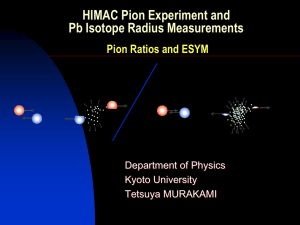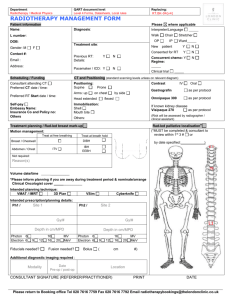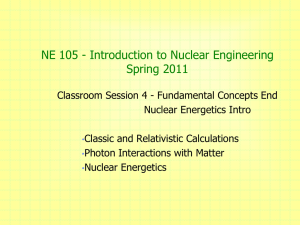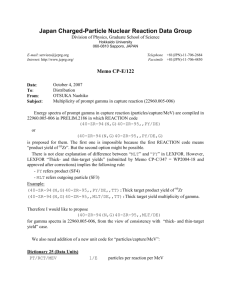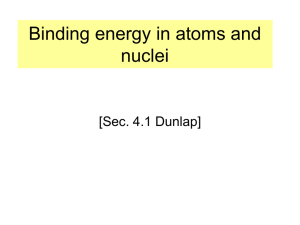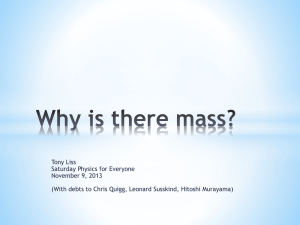Photofission of 232Th and 238U with Bremsstrahlung Photons
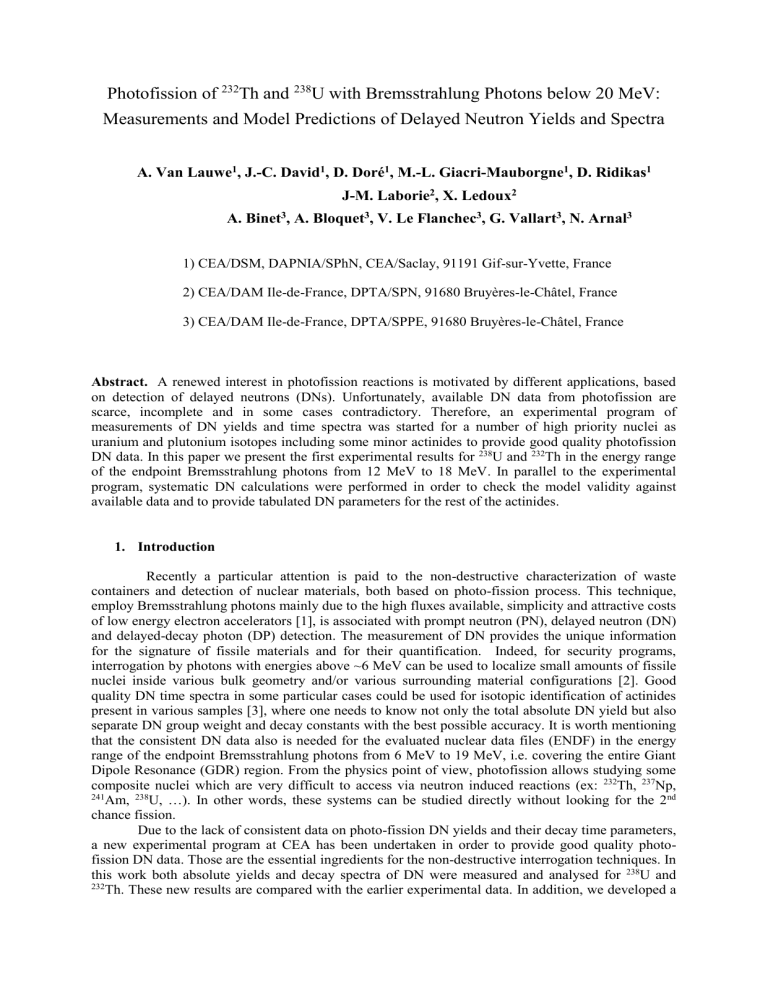
Photofission of
232
Th and
238
U with Bremsstrahlung Photons below 20 MeV:
Measurements and Model Predictions of Delayed Neutron Yields and Spectra
A. Van Lauwe
1
, J.-C. David
1
, D. Doré
1
, M.-L. Giacri-Mauborgne
1
, D. Ridikas
1
J-M. Laborie
2
,
X. Ledoux
2
A. Binet
3
, A. Bloquet
3
, V. Le Flanchec
3
, G. Vallart
3
, N. Arnal
3
1) CEA/DSM, DAPNIA/SPhN, CEA/Saclay, 91191 Gif-sur-Yvette, France
2) CEA/DAM Ile-de-France, DPTA/SPN, 91680 Bruyères-le-Châtel, France
3) CEA/DAM Ile-de-France, DPTA/SPPE, 91680 Bruyères-le-Châtel, France
Abstract. A renewed interest in photofission reactions is motivated by different applications, based on detection of delayed neutrons (DNs). Unfortunately, available DN data from photofission are scarce, incomplete and in some cases contradictory. Therefore, an experimental program of measurements of DN yields and time spectra was started for a number of high priority nuclei as uranium and plutonium isotopes including some minor actinides to provide good quality photofission
DN data. In this paper we present the first experimental results for 238 U and 232 Th in the energy range of the endpoint Bremsstrahlung photons from 12 MeV to 18 MeV. In parallel to the experimental program, systematic DN calculations were performed in order to check the model validity against available data and to provide tabulated DN parameters for the rest of the actinides.
1.
Introduction
Recently a particular attention is paid to the non-destructive characterization of waste containers and detection of nuclear materials, both based on photo-fission process. This technique, employ Bremsstrahlung photons mainly due to the high fluxes available, simplicity and attractive costs of low energy electron accelerators [1 ] , is associated with prompt neutron (PN), delayed neutron (DN) and delayed-decay photon (DP) detection. The measurement of DN provides the unique information for the signature of fissile materials and for their quantification. Indeed, for security programs, interrogation by photons with energies above ~6 MeV can be used to localize small amounts of fissile nuclei inside various bulk geometry and/or various surrounding material configurations [2]. Good quality DN time spectra in some particular cases could be used for isotopic identification of actinides present in various samples
[3], where one needs to know not only the total absolute DN yield but also separate DN group weight and decay constants with the best possible accuracy. It is worth mentioning that the consistent DN data also is needed for the evaluated nuclear data files (ENDF) in the energy range of the endpoint Bremsstrahlung photons from 6 MeV to 19 MeV, i.e. covering the entire Giant
Dipole Resonance (GDR) region. From the physics point of view, photofission allows studying some composite nuclei which are very difficult to access via neutron induced reactions (ex: 232 Th, 237 Np,
241 Am, 238 U, …). In other words, these systems can be studied directly without looking for the 2 nd chance fission.
Due to the lack of consistent data on photo-fission DN yields and their decay time parameters, a new experimental program at CEA has been undertaken in order to provide good quality photofission DN data. Those are the essential ingredients for the non-destructive interrogation techniques. In this work both absolute yields and decay spectra of DN were measured and analysed for 238 U and
232 Th. These new results are compared with the earlier experimental data. In addition, we developed a
modelling procedure to predict DN yields in terms of calculations of photofission fragment distributions and use of existing DN emission probability tables. This work is related to on-going evaluation activity for the photonuclear cross sections for actinides [4] and creation of the
Photonuclear Activation File (PAF) [5].
2. Experimental procedure and results
Photofission DNs were measured for two actinides, namely 238 U and 232 Th. To accumulate necessary statistics within available beam time, large amount of actinide materials (400 g of depleted uranium and 300 g of natural thorium) were irradiated. For each sample “infinitely long”,
“intermediate” and “infinitely short” irradiation periods were performed and followed by variable DN decay measurements. This experimental procedure, as it will be shown later in this work, allows extracting the DN six group parameters with good accuracy. In addition, “infinitely short” irradiation provides an independent method to determine the total yield of delayed neutrons.
2.1 Experimental set-up
The experiments were performed using the ELSA electron accelerator of CEA/DAM Ile-De-
France at Bruyères-le-Châtel (France). A schematic diagram of the general experimental arrangement is shown in Fig 1.
Figure 1: A schematic view of the experimental set-up to measure DN yields from photofission.
ELSA is based on a 144 MHz photo-injector followed by the RF linear accelerator. Beam pulses of 140
s large contain 1-10 successive electron bunches which will be extracted at 2.5 MeV from a photo-injector and then accelerated through the next structure to the final desired energy (up to
19 MeV). The electron beam has a good energy resolution (less than 100 keV) and reasonable beam focalization (~2-3 mm diameter on the Ta converter). Presently the maximum available intensity is limited to 1
A due to radioprotection reasons.
Final energy electrons are converted into Bremsstrahlung photons using a tantalum converter
(1.2 mm thick). The remaining electrons are stopped in a 5 cm thick aluminum cylinder (see Fig 1).
The Bremsstrahlung photons in the forward direction are further “focalized” by a thick lead collimator.
The actinide target to converter distance was ~150 cm. Both uranium and thorium samples are cylinders defined by 3 cm diameter and 3 cm thickness and by 2.6 cm diameter and 5 cm thickness respectively.
The neutron detector is composed of a standard 3 He counter tube under pressure of 4 atmospheres working on the principle of gas ionization via 3 He(n,p) 3 H reactions. The 3 He tubes were placed inside a polyethylene (CH
2
) container in order to increase the neutron detection efficiency in terms of neutron moderation . The 5 cm thickness of the polyethylene was selected in order to get a constant efficiency in the range of expected delayed neutron energy, i.e. between 0.2 to 1.0 MeV. This optimization was done using Monte Carlo simulations and confirmed during the experiments with mono-energetic neutrons. Finally, the polyethylene container was surrounded by 1 mm thick Cd envelope to decrease the background due to re-scattered low energy neutrons. We refer the reader to
Ref. [6] for more details on the experimental set-up and some preliminary results.
2.2 Measurement strategy for total DN yield (
d
) and group parameters (F i
,
i
)
For the determination of the total DN yield a specific measurement has been performed. In general the use of a short irradiation time and long decay time can provide good accuracy for the
measurements if enough statistics is accumulated in the DN decay curve Y
DN
(t). For this purpose a sufficient number of periodic irradiation-decay cycles were done, what was easy to realize with ELSA being a pulsed machine with short pulses of only 140
s large. After a single pulse, photo-injector and
RF linear accelerator were switched off during the defined decay time. Counting synchronization was performed by the start pulse of the accelerator. For a short irradiation time (short compared to the half life of all DN precursors), the
d can be written according to this equation:
d
d
0
Y
DN
N
( t fission
) dt
T irr
, where Y
DN
(t) is the measured DN decay activity after a single irradiation, T irr
corresponds to the irradiation time in seconds,
d
- the total detector efficiency and N fission
- the number of fissions in the target per second during irradiation. The number of fissions is evaluated using the MCNPX code [7] calculations taking into account in detail the experimental set-up.
In order to extract information about DN group parameters, different irradiation-decay time have been used. Indeed, it is well known that the time dependence Y
DN
(t) of the number of fission
DNs emitted after finite irradiation as a result of
-decay of various fission products, known as precursors, can be represented as a sum of exponentials:
Y
DN
( t )
d
6 i
1
F i e
i t
( 1
e
i
T irr )
, where the decay constant
i
= ln 2 / T
1 i
/ 2
, T
1 i
/ 2 being the half-life of the i th precursor, F i
- the contribution of group i. Since the number of DN precursors is very large, they are usually lumped into six groups according to their half-lives in the case of neutron induced fission. A similar approach was adopted to describe the photofission delayed neutrons [8]. The correction in the above equation
( 1
e
i
T irr ) due to the irradiation time allows better distinguishing the contribution of one DN group compared to the others. For this reason data taking campaigns with long (300 s), intermediate (10 s) and short (140
s) irradiation periods T irr
were tried in order to enhance the contribution of different periods of delayed neutron precursors.
The DN decay curves were analyzed using the least square fit method and the above expression was employed for this purpose. In this way using long irradiation-decay periods we were able to extract the DN parameters with good precision for groups 1 and 2. For an intermediate irradiation, according to the previous measurement, groups 3 and 4 were extracted with a good accuracy. Finally, for a short irradiation, the contribution of groups 5 and 6 corresponding to the shortest half-lives were obtained. At this point we conclude that the DN group parameters can be obtained with good precision thanks to the combination of a number of different irradiation-decay campaigns.
2.3 Results
Results of this work, corresponding to the total DN yield
d
for 238 U and 232 Th as a function of the electron energy are shown in Fig. 2. For uranium target, at 15 MeV, our two experimental data sets
(blue and red squares) are consistent within errors bars. In addition, our experimental data are consistent with previous old data at 12 and 15 MeV. Extended to higher energy up to 18 MeV, where no DN yield data existed, our experimental data provide the 1 st insight on the 2 nd chance fission
(photon energy threshold around 12 MeV). It is well known from the neutron induced fission that the total DN yield v d
considerably decreases (by 30-40 %) once the 2 nd chance fission opens, i.e. around 6
MeV for neutron induced reactions. One would expect to observe a similar behavior in the case of photofission but at some smaller extent since in our case we used a white Bremsstrahlung spectrum instead of mono-energetic photons. Indeed, with both uranium and thorium targets our preliminary data shows a decrease of v d from ~0.030-0.032 at 10 MeV down to 0.026-0.024 at 18 MeV, what is larger than expected error bars.
We note that the decrease in
d
of similar order is also obtained by the model calculations, presented by continuous red lines in the same Fig. 2. Some details on these predictions will be discussed in the coming section.
Figure 2: Total DN yield as a function of electron energy for
238
U (top) and
232
Th (bottom).
Our experimental results for DN six group yields are presented in Fig 3 together with existing old data reported by Nikotin et al. [8] and Kull et al. [9]. Note that already Kull et al. in the case of
238
U has observed some important differences for groups 4 and 6 (when compared to Nikotin’s results). At that time these variations were explained in terms of the effects related to the 2 nd chance fission.
To clarify this situation, we performed experimental measurements both at 15 MeV (to confirm Kull’s interpretation) and at 18 MeV (to increase the expected influence of the 2 nd chance fission effects). In brief, the agreement between our measurements with Kull’s data at 8 and 10 MeV is very good, i.e. our measurements remain in contradiction and Nikotin’s results. Moreover, our result at 18 MeV (in blue) is very close to the data at 15 MeV (in red), which is against Kull’s interpretation that the 2 nd chance fission can influence the DN spectral parameters. After detailed analysis of
available information concerning the old work by Nikotin et al. [8], we realized that during this experiment no short pulse irradiations were performed. As a consequence, the parameters for group 6 with the shortest half-life could not be extracted without ambiguities, and group 4 had to be adjusted to compensate the missing weight to add to 100 % (see the same Fig. 3 on the top).
The results for thorium, presented in Fig. 3 on the bottom, lead to similar conclusions as for uranium. Again important discrepancies are identified for group 6 compared to Nikotin’s data, and no significant difference for the DN spectral parameters between 15 and 18 MeV is observed. We conclude at this point that Nikotin’s DN parameters obtained at 15 MeV should be corrected.
Figure 3: Experimental data for DN group contribution in( %) as a function of group number and incident electron energy: on the top – for uranium, on the bottom – for thorium.
2.4 Consequence of precise data for applications
The importance of good quality DN data is emphasized in the following example. As it was explained in Ref. [2], for some applications as ‘isotopic identification” by DN decay spectra of mixed samples containing several actinides, base lines (corresponding to F i
and
i
) of single actinides should be known with high precision.
To confirm these recommendations we performed additional experiment using the mixture of
400 g of
238
U and 300 g of
232
Th. Fig. 4 presents the accumulated DN decay spectra after a short pulse
(140
s) irradiation together with parameterized curves, corresponding to the base lines and summed mixture signal, using old Nikotin’s parameters and those of this work. The need of good quality DN data is evident from this simple example.
Figure 4: on the left: experimental DN spectra obtained with the mixed 238 U+ 232 Th sample after a short irradiation (in black) compared to the base lines of DN spectra for the uranium (green), thorium (blue) and summed mixture (in red) using old Nikotin’s parameters; on the right: the same just with base line parameters for uranium and thorium obtained in this work.
In addition, we tried somewhat more sophisticated approach to analyze the measured DN spectra with mixed sample. The measured curve was fitted with base line parameters given by Nikotin et al. and by this work to obtain Th and U mass ratio with a known total mass of the sample in order to determine the mass contribution of each actinide. In brief, with new base line parameters we obtained a good quality fit (not shown here), which resulted in ~375 g of uranium and ~325 g of thorium in the mixture. On the other hand, no reasonable fit could be obtained using old base line parameters reported by Nikotin et al. in [8].
3. Formation of DN tables
3.1 Description of modelling
In order to take into account the full process of photonuclear reactions and photofission in particular, the modelling can be described through several steps presented in Fig 5. First of all, the
Bremsstrahlung photon spectrum inside the actinide sample is calculated with the MCNPX code [7] taking into account the exact experimental set-up. In the
-excitation of nucleus we considered only the Giant Dipole Resonance contribution, where an empirical systematic based on the sum of two
Lorenzian distributions seems to describe this process properly below 20 MeV. For more details on modeling of photonuclear reactions in the case of actinides we refer the reader to Ref. [10].
The de-excitation of the nucleus is treated by the ABLA model developed at GSI [11] known to give good results in the case of high energy spallation reactions. Competition between particle emission and fission is performed by a statistical model. In other words, the complete code provides neutron emission, fission cross section and also fission yields. Note that the multi-chance fissions are taken into account as well.
To treat the calculation of DNs, the independent fission yields predicted by ABLA are transferred into cumulative yields using the CINDER’90 transmutation-decay code [12]. The DN
precursors are identified and selected according to the nuclear data tables. Using tabulated DN emission probabilities and half-lives, all precursors are merged into six DN groups according to their half-lives. In this way the model provides a full set of DN parameters (total yield
d
, six group yields
F i
and averaged group time constants
i
= ln 2 / T
1 i
/ 2
).
Figure 5: Schematic view of the construction of six group DN neutron tables in the case of photofission.
3.2 Prediction of photofission yields
To check the validity of the predicted DN values, we compared the model results with scarce but existing experimental data (photofission product mass and isotopic distributions, DN six group parameters). Here we focused only on the results in the case of uranium isotopes, since they are the actinides experimentally investigated most of the time.
Fig. 6 shows the yields of photofission fragments for
235
U and
238
U. Our predictions
(histograms) are compared to 15 and 25 MeV Bremsstrahlung data (squares) (data from [13] [14]
[15]). In brief, the widths and positions of the peaks are well reproduced by the calculations (lines) while the heights are slightly different. Note that some parameter adjustment was necessary within the
ABLA code to obtain this agreement with data.
Figure 6: Photofission fragment mass distributions on
235
U and
238
U in the case of 15 MeV and 25 MeV
Bremsstrahlung photons.
Fig. 7 also shows some model predictions in the case of isotopic distributions for 238 U at 20
MeV. In general the agreement between the experiment [16] and calculations is rather good. Similar quality results were obtained also for 235 U (not shown in this work). Note that these isotopic yields are much more sensitive than mass yields to the observable we are interested in, namely constructed DN tables.
Figure 7: Isotopic distribution for photo-fission of
238
U at 20 MeV Bremsstrahlung.
3.3 Predictions of DN parameters
Model predictions of the total DN yields
d
were already presented in Fig.2, where the small decrease in
d
as a function of electron energy is observed. This result is not surprising , andthe model also predicts roughly the behavior of the experimental ratio
(
,
fiss )
(
,
fiss
(
,
) n
fiss )
. The agreement between the measured total DN yields with those calculated is also in good agreement in absolute value for
238
U as function of electron energy. For 232 Th the model predictions overestimate the data slightly (see the same Fig. 2). On the other hand, the shape of the electron energy dependence is in good agreement with data. It would be interesting to extend these measurements also above 20 MeV and for other nuclei.
Calculated averaged half-lives of DNs for
238
U at 15 and 18 MeV Bremsstrahlung energies are compiled in Table 1 and compared with the corresponding experimental values obtained in this work.
In general, the predictions are in a good agreement with experiment, and the same is valid for 232 Th.
238 U at 15 MeV 238 U at 18 MeV
Group T
1/2
(experiment) T
1/2
(model) T
1/2
(experiment) T
1/2
(model)
1
2
55.6
21.88 ± 0.66
55.6
21.9
55.6
21.7 ± 0.3
55.6
21.9
3
4
5.01 ± 0.49
2.07 ± 0.14
5.21
1.89
4.84 ± 0.23
1.84 ± 0.15
5.2
1.91
5
0.584 ± 0.051
0.46
0.577 ± 0.15
0.46
6 0.174 ± 0.019 0.185 0.21 ± 0.03 0.185
Table 1: Averaged half- lives of DN groups for
238
U at 15 and 18 MeV: comparison between experiment and model predictions. Note that for group 1, only 87 Br contributes with T
1/2
=55.6s
Finally, for the DN group fractions F i
although the agreement is rather good, we found some noticeable discrepancies between the modelling and the experimental data as shown in Fig. 8. We note that systematically similar differences were obtained both for 238 U and 232 Th. By now we have not found yet a possible explanation for these disagreements.
Figure 8: Comparison of DN group fractions F i
in (%) obtained from model calculations and experiment for
232
Th and
238
U at 15 MeV. See the legend for details
4. Summary and outlook
We launched an experimental program to measure photofission DN yields and their time characteristics for number of actinides in the range of Bremsstrahlung photons from the photofission threshold of ~6 MeV up to 18 MeV. The first results for 238 U and 232 Th presented in this paper are very encouraging. Our measurements clarified the situation with the old data for DN group fractions: the old data at 12 MeV was confirmed, while 15 MeV data are corrected both for uranium and thorium. In addition, new data at 18 MeV for both of these nuclei were reported. Finally, extension of the DN measurements from the incident energy of 15 MeV to 18 MeV allowed testing the effects of the 2 nd chance fission for the total DN yields. The importance of these new measurements for some of the applications was outlined and successfully tested experimentally.
In parallel to the experimental program, systematic calculations were performed to provide photofission DN tables for all actinides. Comparison of these model predictions with experimental data was very satisfying: both
d
and DN group parameters were well reproduced by the modelling, although some improvements are still necessary.
Our future work (both experiment and modelling) will concentrate on other important actinides as 235 U, 239 Pu and 237 Np.
References
[1] D. Ridikas, P. Bokov, M.-L. Giacri, “Potential Applications of Photonuclear Processes: Renewed
Interest in Electron Driven Systems”, Proceedings of the Int. Conf. on Accelerator Applications -
Accelerator Driven Transmutation Technology and Applications (AccApp/ADTTA'03), 1-5 June
2003, San Diego, California, USA.
[2] M. Gmar et al., “Detection of nuclear material by photon activation in cargo containers: Nonintrusive detection technologies”, Proceedings of SPIE Defence and Security Symposium, 17-21 April
2006, Orland, Florida, USA.
[3] X. Li, R. Henkelmann and F. Baumgärtner, “Rapid determination of uranium and plutonium content in mixture through measurement of the intensity-time curve of delayed neutrons”, Nuclear
Instruments & Methods in Physics Research B215 (2004) 246.
[4] E. Dupont et al, “Photonuclear Data Evaluation for Actinides”, Proceedings of this conference
(2006) in print.
[5] D. Ridikas et al. “Status of the Photonuclear Activation File: reaction cross sections, fission fragments and delayed neutrons”, Nuclear Instruments & Methods A 562 (2006) 710.
[6] D. Doré et al., “Delayed neutron yields and spectra from photofission of actinides with
Bremsstrahlung photons below 20 MeV”, EPS Journal of Physics: Conference Series 41 (2006) 241.
[7] J. Hendricks, et al., “MCNPX extensions: version 2.5.0”, LA-UR-05-2675, LANL, USA, April
2005.
[8] O.P. Nikotin and K.A. Petrzhak, “Delayed neutron in the photofission of heavy nuclei”, Atomnaya
Energya 20 (3) (1965) 268.
[9] L.A. Kull, R.L Bramblett, T. Gozani and D.E. Rundquist, ”Delayed neutrons from low energy photofission”, Nuclear Science & Engineering 39 (1970) 163.
[10 ] M-L. Giacri-Mauborgne, D. Ridikas, M. Chadwick, P. Young, W. Wilson, “Photonuclear Physics in Radiation Transport - III: Actinide Cross Sections and Spectra, Nuclear Science and Engineering,
Vol. 153, n°1 (2006) 33.
[11] A .
R. Junghans et al., “ Projectile-fragment yields as a probe for the collective enhancement in the nuclear level density”, Nuclear Physics A 629 (1998) 635; J. Benlliure et al., “Calculated nuclide production yields in relativistic collisions of fissile nuclei”, Nuclear Physics A 628 (1997) 458.
[12] W. B. Wilson, T. R. England and K. A. Van Riper “Status of CINDER’90 Codes and Data”, Los
Alamos National Laboratory, report LA-UR-99-361 (1999).
[13] E. Jacobs, H. Thierens, “Product yields for the photofission of
238
U with 12-, 15-, 20- , 30- and
70-MeV bremsstrahlung”, Physical Review C19 (1979) 422.
[14] H. Thierens, D. De Frenne, E. Jacobs, A. De Clercq, P. D'hondt & A.J. Deruytter, ”Product yields for photofission of
235
U and
238
U with 25-MeV bremsstrahlung”, Physical Review C14 (1976) 1058.
[15] E. Jacobs, H. Thierens, D. De Frenne, A. De Clercq, P. D'hondt & A.J. Deruytter, ”Product yields for photofission of
235
U with 12-,15-,20-,30-,70-MeV bremsstrahlung”, Physical Review C21 (1980)
237.
[16] D. De Frenne et al., “Isotopic distributions and elemental yield for the photofission of
238
U with 12-30MeV bremsstrahlung”, Physical Review C29 (1984) 1908
235
U and


